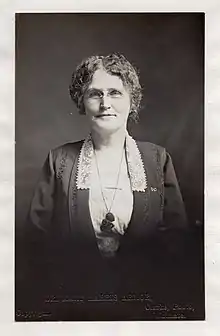Mary Harris Armor
Mary Elizabeth Harris Armor (sometimes spelled Armour; March 9, 1863 – November 5, 1950) was an American suffragist. She was the state president of the Woman's Christian Temperance Union (WCTU) and is often credited for the passing of prohibition legislature in Georgia.
Mary Harris Armor | |
|---|---|
 | |
| Born | March 9, 1863 Eastman, Georgia |
| Died | November 5, 1950 (aged 87) |
| Known for | Georgia State President of the Woman's Christian Temperance Union |
| Spouse(s) | Walter Florence Armor
(m. 1883) |
Personal life
Mary Elizabeth Harris was born on March 9, 1863 in Georgia to physician William Harris. She married Walter Florence Armor in August 1883.[1]
Career
Armor often used the suffragette movement to advocate for prohibition in Georgia. Between 1903 and 1915, while serving in state and national offices with the WCTU, she lobbied for Congress to "protect women and children especially through prohibition legislature."[2] As a result, Armor is often credited for the passing of prohibition legislature in Georgia.[3] Upon the passing of a State-wide prohibition law in 1907, the newspaper Atlanta Constitution described her as the voice "that aroused the Christian conscience of the State and put it on the march."[4] She predicted that "brewery stock in this country will not be worth as much as Confederate money was in 1865."[5]
Armor was often nicknamed the "Georgia Cyclone."[6] She lectured and campaigned across the United States for the prohibition cause. Her speeches were so moving she was sometimes referred to as "Joan of Arc." In one instances, she raised $7,000 for WCTU in one night through an empowering speech.[7] As a result of her campaigning, Armor was the recipient of an honorary law degree from Wesleyan College in 1918.[8] During the 1920s, she travelled to New Zealand to promote prohibition.[9][10]
However, Armor and the WCTU campaigned for prohibition on a racial based platform. On their maps of "wet and dry" counties came with the caption "Shall the Blacks rule the Whites?" As part of her movement, Armor attempted to get Fred Loring Seely of The Atlanta Georgian to allow the WCUT to publish prohibition propaganda in his newspapers. He refused as his newspaper was presenting the prohibition as an assertion of masculinity.[11] Upon the passing of the Nineteenth Amendment to the United States Constitution, she joined the League of Women Voters.[1]
Armor died on November 5, 1950.[1]
References
- "Biographical Sketch of Mary Harris Armor". alexanderstreet.com. Retrieved November 7, 2019.
- Jonathan Daniel Wells; Sheila R. Phipps (December 1, 2009). Entering the Fray: Gender, Politics, and Culture in the New South. University of Missouri Press. p. 50. ISBN 9780826272089. Retrieved November 7, 2019.
- "Mary Harris Armor". ahgp.org. Retrieved November 7, 2019.
- "DR MARY HARRIS-ARMOR, OF GEORGIA, CTD". wvgal.tripod.com. July 1949. Retrieved November 7, 2019.
- "SAYS LIQUOR IS DOOMED.; Brewery Stock to be Worthless in Five Years, Mrs. Armor Predicts". New York Times. Kansas City. March 30, 1914. Retrieved November 7, 2019.
- Staci Catron-Sullivan; Susan Neill (February 2, 2005). Women in Atlanta. Arcadia Publishing. p. 86. ISBN 9781439629741. Retrieved November 7, 2019.
- "The part taken by women in American history". archive.org. pp. 668–669. Retrieved November 7, 2019.
- "History". wesleyancollege.edu. Archived from the original on July 18, 2019. Retrieved November 7, 2019.
- Tyrell, Ian (July 1, 2010). Reforming the World: The Creation of America's Moral Empire. Princeton University Press. p. 215. ISBN 9781400836635. Retrieved November 7, 2019.
- Tyrrell, Ian (March 19, 2014). Woman's World/Woman's Empire: The Woman's Christian Temperance Union in International Perspective, 1880-1930. UNC Press Books. p. 278. ISBN 9781469620800. Retrieved November 7, 2019.
- Carol Nackenoff; Julie Novkov (January 6, 2014). Statebuilding from the Margins: Between Reconstruction and the New Deal. University of Pennsylvania Press. pp. 89–90. ISBN 9780812209075. Retrieved November 7, 2019.